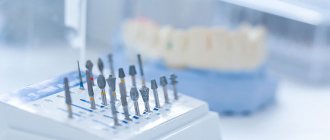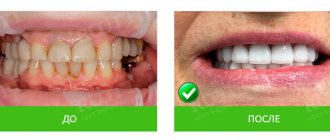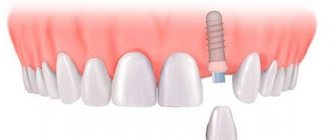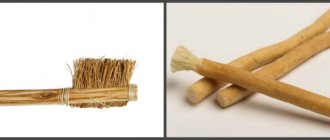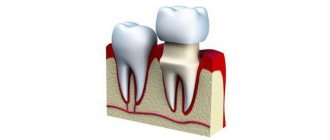As a rule, we are accustomed to associate dental prosthetics only with people of the older generation.
However, in modern orthopedics there are no age restrictions.
Sometimes, those with baby teeth also need dental restoration.
Often the need for this procedure at an early age arises in the event of destruction of a temporary crown long before the eruption of a permanent tooth.
Complications of early loss
There are certain standards for the eruption of permanent teeth. The loss of time units begins at the age of six and lasts, on average, up to 12 years. It is during this period that the rudiments of permanent organs are formed, which displace the milk ones.
But, unfortunately, temporary units do not always remain healthy and intact throughout their lives. It happens that the organ is destroyed much earlier than the specified time frame.
A number of reasons contribute to the early loss of milk units:
- injuries, mechanical damage, bruises;
- malnutrition;
- lack of quality oral care;
- unfavorable environmental conditions;
- concomitant diseases or taking a certain group of drugs.
The gap between the teeth in case of untimely loss or destruction of the milk organs will remain until the rudiments of permanent teeth are formed and they begin to erupt.
If you ignore this problem, you may encounter a number of complications:
- pathology of growth and formation of bone tissue at the site of the defect, which subsequently leads to difficulty in eruption;
- uneven distribution of load between the remaining crowns during chewing, which can result in their damage;
- problems of the digestive system due to insufficient food processing;
- decrease in the height of the dentition;
- pathological eruption of permanent crowns. If there is a defect, neighboring organs move over time towards the formed space, so the formed rudiment makes its way behind the arch, above the dentition, etc.;
- diseases of the temporomandibular joint;
- formation of malocclusion;
- speech quality disorders;
- psychological disorders due to the appearance of complexes.
Why do you need dentures for baby teeth?
As it has become known, untimely loss of baby teeth in young children leads to disruption of the child’s chewing function, which subsequently leads to loss of health of the entire body. In addition to this, the absence of teeth spoils the child’s appearance, which causes the development of an inferiority complex.
The natural period when baby teeth are replaced with permanent ones is 6-12 years. It is during this period that the skeleton is fully formed. Therefore, prosthetics of primary teeth in children can be performed from the age of 5 years.
Indications
You should seek the help of an orthopedic dentist:
- With the clinical picture of fluorosis, a chronic disease characterized by segmental darkening of the enamel.
- With significant progression of caries, when it is not possible to eliminate the problem using filling.
- If the crown is damaged as a result of trauma.
- In the case of the development of an inflammatory process of the periosteum, when removal of the organ is the only solution to the problem.
- With pathological untimely loss.
- In case of loosening of bone organs due to developing periodontitis.
- If it is necessary to preserve the appearance of the frontal zone after caries treatment.
The video details the indications for installing crowns on baby teeth.
Contraindications
There are no absolute contraindications for breast prosthetics, except for mental or neurological diseases. All other factors that temporarily prevent the possibility of carrying out a dental procedure can be eliminated.
It is not recommended to resort to prosthetics:
- with concomitant non-systemic diseases that are in the acute stage;
- if the child has recently undergone a course of radiation therapy;
- after severe psychological stress;
- in the absence of proper oral hygiene;
- if the child is not psychologically ready to withstand the prosthetic procedure.
When eliminating the defect, an allergic reaction to the materials from which the prostheses are made cannot be ruled out. However, they can be selected and replaced.
Varieties
Dental restoration in children can be done using both removable and fixed dentures.
Fixed
This type of construction is used for partial destruction of the crown and preservation of healthy roots.
Classic crowns
The prosthesis, which covers the defect in order to avoid complete destruction of the tooth, is made of metal.
Typically, technicians use chromium-nickel alloy or stainless medical steel.
Strip crowns
As a rule, they are used to replace anterior units and are removable caps made of light-curing composite or acrylic.
Prosthetic crowns are indicated for significant carious lesions, as well as their injuries and changes in enamel color under the influence of various factors.
Installation of a prosthesis requires preliminary preparation of hard tissue, when the affected areas of the milk crowns are removed, the tooth is formed for the prosthesis - it is turned.
In general, the entire installation process from the start of preparation to putting on the cap takes up to 20 minutes.
The strip crown is selected before tooth preparation begins and is fixed with special cement.
Read why your jaw hurts when chewing and how to get rid of the problem. Watch here a detailed video of tooth extension on a pin.
At this address https://dr-zubov.ru/lechenie/zuby/znachenie-i-primenenie-premedikacii.html we suggest finding out what drugs are used for premedication in dentistry.
Tabs
The use of a method for treating organs affected by caries without affecting the pulp or with an increased level of enamel abrasion is carried out with the aim of restoring the anatomical shape of the crown.
Unlike conventional fillings, inlays are manufactured in a laboratory and are made from various metal alloys or plastics. The product is installed in the prepared tooth cavity and prevents its further destruction.
As a result of an effective prosthetic technique, the mammary organ maintains its integrity even under significant mechanical stress.
Pin tabs
Recommended for carious lesions affecting the pulp and maintaining the health of the roots. It is possible to restore the integrity of a tooth even if there is practically nothing left of the crown.
Before installation, careful preparation is carried out - the canals, which are wide and short in children, are opened and processed. Preparation of the tooth cavity significantly thins it, so it is important to very carefully fix the pin in the root.
Chromium-nickel or gold alloys are used to make inlays. Porcelain or plastic facets are used as an artificial crown.
Due to the difficulties of installing the pin, prosthetics using this method is recommended only in cases where restoration by another method is not possible.
Removable
From previous designs, removable products can be easily and independently removed from the oral cavity if necessary.
Lamellar dentures
This type of construction is most often prescribed by specialists for dental restoration. The installation of a prosthesis is resorted to when there is a significant or complete absence of one’s own organs.
A plate product is a structure that consists of a plastic base with fasteners. Sometimes, this type of construction is also used in orthodontics to correct the bite.
Bridges
Prescribed in the absence of three or more milk units. The bridge-like structure is fixed by fastening elements to the remaining supporting organs.
The product is usually made from various plastics with the addition of other materials for fastening.
Butterfly
Prosthetics with this design are carried out, as a rule, to restore one unit.
The butterfly is a one-piece nylon-based product made from thermoplastic materials. Elastic fastenings - clasps make it possible to secure the structure to adjacent crowns.
Types of children's prostheses
Among children's dentures, a distinction is made between removable and non-removable products.
Removable ones are used if the child is missing a number of teeth. In this case, a removable structure will help to establish the correct distribution of teeth. As the child grows, the dentures must be replaced.
Dentures for permanent wear are non-removable and are removed together with baby teeth that fall out.
Read Repairing dentures at home: how to fix them, how to glue them, how to bend them
Removable
Removable structures include:
- Bridges that can be moved apart.
- Lamellar dentures to create a correct bite.
- Immediate – prostheses – “butterfly”.
- Crowns for temporary use.
- In case of complete absence of dentition, dentures with an elastic lining are used.
Fixed
Non-removable structures include:
- Tabs
- Crowns
- strip crowns
- pin tabs
Those. those types of structures with which you can restore teeth that have roots. Pin tabs
This type is used for severe destruction of a tooth, as well as for root destruction and nerve removal. Pins are made from types of metal such as chromium-nickel compounds, as well as an alloy of gold and platinum. The crown is made of porcelain or ceramics.
Crowns
Children are given crowns in cases where changes in the teeth cannot be corrected either by a filling or an inlay. For teeth that bear the main chewing load, crowns are made of medical steel. The front teeth are made of different types of metal; plastic, metal-ceramics or porcelain are used for coating. A soldered crown is used to treat two adjacent teeth.
When applying complex dental prosthetics to children, you need to remember that the child’s jaw is in the process of formation. Therefore, an experienced dentist must make every effort not to disrupt this process.
Strip crowns
Strip crowns are used for teeth in the frontal area. They are transparent acrylic caps. They are placed on the tooth within 20 minutes. They produce 16 types of sizes. Strip crowns are good for both temporary and permanent wear. They fall out along with the baby tooth.
Tabs
Microprostheses - inlays made of various metal alloys help to recreate the original shape of the tooth. The dental pulp is preserved.
What requirements must be met?
Unlike adult prostheses, increased requirements apply to children's prostheses. This is due to the fact that the child’s body is in the growth stage. Jaw growth should not be prevented. In addition, children react especially acutely to various components of prostheses. The child’s body cannot fully fight spreading microorganisms. Therefore, the composition of the structures should not cause harm to health. And one more important requirement - when installing the structure there should not be any additional damage.
Read Adhesive dental prosthetics - what is it, before and after photos, methods and types
Requirements
Prosthetics for dental restoration must meet strict quality criteria, since the jaws of young orthopedic patients are just developing.
Safety of use
All prostheses intended for younger patients must, first of all, be safe for their health.
According to safety requirements, the design cannot injure the oral mucosa. It should be easily fixed (in the case of removable dentures) and not create difficulties during care.
In general, the following requirements are put forward for the product:
- the prosthesis should not become a barrier to the growth of permanent organs and the formation of dental arches;
- the design can only be comfortable during operation;
- the prosthesis should not interfere with the appearance.
What are Quadrotti removable dentures and in what situations is their use rational? This article provides detailed information about the timing of crown installation after a healing abutment.
Follow the link https://dr-zubov.ru/ortopediya/semnye-protezy/byugelnye/vidy-na-nizhnyuyu-chelyust-i-foto.html if you are interested in the types of clasp dentures for the lower jaw.
What materials are they made from?
The child's body is quite difficult to perceive a foreign body in the oral cavity. Therefore, it is so important to select individual hypoallergenic materials for the construction.
In addition, they must:
- be resistant to shrinkage and plaque formation;
- durable and lightweight at the same time;
- resistant to mechanical damage;
- repel moisture.
In special dental laboratories, technicians work with stainless steel, acrylic, various alloys, which may include tin, silver or gold, nylon and others.
Design requirements
Designs intended to be used for children are subject to more stringent requirements regarding their quality and safety. This is explained by the fact that the child’s body is not yet fully formed and continues to grow and develop. Children are also more sensitive to the effects of various materials.
Safety of use
This requirement concerns safety for children's health. None of the prostheses should injure or injure the mucous membranes and tissues. They should be easy to attach (if you plan to install a removable version of the product) and not create problems when wearing and caring.
The following requirements apply to each placed product:
- Atraumatic.
- Simplicity of design.
- Should not interfere with external aesthetics.
- Comfort during use.
- Should not interfere with jaw development and tooth growth.
The installation of dentures must take place without damaging adjacent teeth, i.e. without facing.
Material of manufacture
The presence of a foreign body in the oral cavity is difficult for a child's body to tolerate. It is for this reason that only hypoallergenic materials are used to make prostheses.
They also have other requirements. They should be:
- hygienic, i.e. resistant to plaque formation;
- do not shrink;
- resistant to mechanical damage;
- durable but lightweight;
- do not swell or deform from humidity.
Prostheses for children are allowed to be made from materials that meet all the above requirements: acrylic plastic, stainless steel (grade EI-95), alloys of gold, silver and tin, nylon and chrome steel.
Manufacturing and installation
Without dwelling individually on each type of removable and fixed prosthesis design, it can be noted that the installation process consists of the following stages:
- consultative examination of the child’s oral cavity;
- if necessary, conduct an x-ray examination;
- preparation of teeth and oral cavity for prosthetics, treatment of affected crowns, their preparation;
- taking impressions;
- manufacturing the product in the laboratory;
- installation of the structure.
It is worth noting that the installation of some types of prostheses is carried out under local anesthesia. In some cases, specialists may resort to general anesthesia.
Wearing and care
Service life and duration of wearing are different concepts in pediatric orthopedics. Removable structures, if necessary, should be changed over time, but non-removable ones remain in the oral cavity until the mammary organ is replaced with a permanent one.
Depending on the type of lost tooth, the duration of prosthetics can range from 3 months to a year and a half. At the same time, parents must monitor the quality of the hygiene procedure.
Fixed dentures only require regular twice-daily cleaning with a brush and paste. But removable structures require compliance with certain rules. In addition to the standard procedure for oral hygiene, the denture should be cleaned: morning and evening - with a brush and paste, after each meal, the product should be rinsed under running water.
At night, the structure is removed from the oral cavity and stored in a special antiseptic solution.
To learn how the process of dental prosthetics is carried out in children, watch the video.
Why a child may have missing teeth at an early age
The most common reason why the teeth do not form in a timely manner is caused by a child’s deficiency of calcium, phosphorus and vitamin D. The lack of these vitamins can be a consequence of infectious diseases suffered during pregnancy.
Read New generation dentures - without palate, new design, prices and photos
One should not discount the illness of children with rickets or diseases of the gastrointestinal tract. Diseases of the thyroid and parathyroid glands also affect tooth growth.
What are the consequences of early loss?
During the chewing process, the load on the dentition is distributed evenly. If one or a row of teeth is missing, the main burden falls on the remaining units. Empty spaces are occupied by incisors or molars, and new teeth begin to grow out of place. This leads to chaos in the child's mouth, which can lead to malocclusion and impaired diction that will be present throughout life. Indications and contraindications for pediatric dental prosthetics in children
Indications for children's dental prosthetics:
- The baby tooth is exposed to the destructive effects of caries. As a result, the dental unit cannot be restored.
- Fluorosis disease. It appears even before teeth begin to appear.
- Removal of a dental unit due to inflammatory processes developing in the periosteum.
- The child has periodontitis.
- The process of loss began ahead of time.
- Getting a dental injury.
- Bruxism.
- Edentia.
There are no special contraindications for prosthetics for children. The restrictions set by the doctor are temporary.
These include:
- the presence of chronic diseases in acute or aggravated form;
- the child cannot overcome the psychological barrier;
- The oral cavity requires bringing it into a satisfactory condition.
Prices
The approximate cost of each type of structure is given in the table below:
| Type of prosthesis | Price in rubles |
| Classic | 8 500—9 000 |
| Strip crowns | 5 000 |
| Tabs | 2 000—10 000 |
| Pin tabs | 2 000—5 000 |
| Lamellar dentures | from 1 000 |
| Bridges | from 1 000 |
| Butterfly | from 1 000 |
In the last three cases, the cost of fastening structural elements is taken into account separately.
Also, the price of a prosthesis largely depends on the type of material from which it is made. The work of a specialist is also assessed individually.
The above amounts do not include the price of preparation, as well as treatment of crowns before prosthetics, which depends on the number of affected teeth and sometimes reaches 10,000 rubles.
Prices for dental prosthetics for children
The cost of prosthetics for primary teeth depends on the category of the clinic, the qualifications of the specialist, the amount of work of the dental technician and the material from which the prosthesis will be made. Moreover, the initial consultation with a pediatric dentist in most clinics is free.
| Type of prosthesis | Price |
| Removable denture made of acrylic | from 12,000 rubles |
| Bridge prosthesis | from 25,000 rubles |
| Clasp denture | from 30,000 rubles |
| Quadrotti removable denture without palate | about 32,000 rubles |
Reviews
According to reviews, not all parents realize the importance of dentures for baby teeth. Some consider this measure useless and detrimental to the family budget, while others, on the contrary, are doing their best to preserve the health of baby teeth.
What do you think about this? Have you ever experienced premature loss of baby teeth in children? Share your experience by leaving a comment below the article.
If you find an error, please select a piece of text and press Ctrl+Enter.
Prevention of dental prosthetics in children
Premature loss of baby teeth, and therefore dental prosthetics in children, can be avoided if you promptly and regularly visit a dentist who diagnoses the condition of the teeth, identifies possible bite defects and diseases of the oral cavity. Proper dental care and attendance at preventive examinations will eliminate the problem at the initial stage, avoid tooth loss and the need for prosthetics. The child’s nutrition also plays an important role in the preservation of baby teeth. After all, if there is a lack of substances necessary for a growing body, teeth are destroyed on their own, without mechanical impact on them. Currently, with busy parents and unfavorable environmental and economic factors, the condition of children’s teeth is worsening every day and prosthetics of baby teeth is becoming increasingly important. Therefore, preventive measures should be taken to maintain dental health from an early age.

